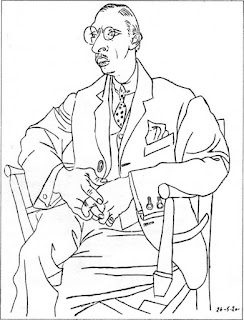Drawing on the right side of the brain
When I was
in high school, my art teacher gave us an activity that completely transformed
how I saw drawing. This structured activity, lasting only one lesson, has
stayed with me ever since and I have so much gratitude for Mr C for sharing
this with me because it really improved my drawing. Since becoming a teacher
and using this activity myself, I now know that the creator of this invaluable
activity is Betty Edwards, and she published it in her book “Drawing on the
Right Side of the Brain” in 1979.
In a
previous post The Secret to Drawing, I wrote that the key to drawing better
is in learning how to see. Keen observation will teach you where to put lines
and shadows, but this can be tricky to teach. Often there is so much going that
it becomes overwhelming! Look at this drawing by Picasso.
It is a complex
network of lines, not to mention the use of foreshortening. To draw this
accurately would be beyond most people, but Edwards has a trick for you that
would make this possible: use the right side of the brain.
 |
| Portrait of Igor Stravinsky by Pablo Picasso |
We all know
that there are two sides of the brain, each having different functions. The
left side deals with numbers, sequences, words and language. It is your
rational and verbal brain. It works quickly, labelling and categorising information for you. The right side deals in patterns, pictures and holistic
thinking. It is your intuitive and non-verbal brain. This is the brain we want
to draw with, but our left-brains tend to dominate like noisy parrots because it
deals with language. So how do we switch from left brain to right brain mode?
Let’s go
back to our Picasso drawing. Here’s the trick, ready?
Turn it
upside down.
The image
is hard to recognize upside down. The left brain can’t “read” the scrambled image
or identify any of the parts. Instead it is left with a mess of lines and
shapes and the left brain gives up. Now the right brain, master of non-rational
thinking, is free to digest the mess of information differently. When looking
at the image upside down, you can focus on the lines without labelling them as ‘hands’,
‘trousers’ or whatever. The attention is on the angle or length of the lines
and this leads to more accurate drawing.
Try it for
yourself. If you want to see the difference it makes turning it upside down,
try drawing it the right way up first. I guarantee you it will be more accurate
drawn upside down.
Happy drawing,
Until next time,
Erin
PS - Here's my upside-down drawing :)




Comments
Post a Comment